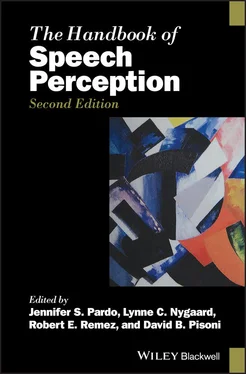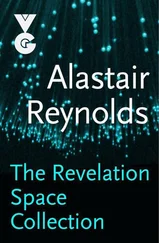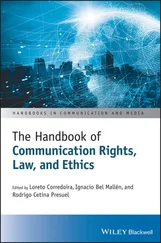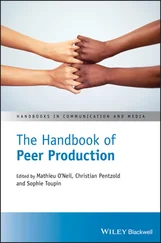1 Cover
2 Series Page
3 Title Page
4 Copyright Page
5 List of Contributors
6 Foreword to the Second Edition
7 Foreword to the First Edition
8 Preface
9 Part I: Sensing Speech 1 Perceptual Organization of Speech Perceptual organization and the gestalt legacy The plausibility of the generic account of perceptual organization The perceptual organization of speech Implications of perceptual organization for theories of speech perception Conclusion Acknowledgments REFERENCES 2 Primacy of Multimodal Speech Perception for the Brain and Science Ubiquity and automaticity of multisensory speech The double‐edged sword of the McGurk effect Multimodal speech is integrated at the earliest observable stage Supramodal speech information Specific examples of supramodal information General examples of supramodal information Conclusions REFERENCES 3 How Does the Brain Represent Speech? Introduction Encoding of speech in the inner ear and auditory nerve Subcortical pathways Primary auditory cortex What does the higher‐order cortex add? Systems‐level representations and temporal prediction Semantic representations Conclusion REFERENCES 4 Perceptual Control of Speech Perceptual feedback processing Models of feedback processing Auditory feedback and vocal learning Perception–production interaction Conclusion REFERENCES
10 Part II: Perception of Linguistic Properties 5 Features in Speech Perception and Lexical Access Preliminaries Feature dimensions Features: Binary or graded Feature representations: Articulatory or acoustic Conclusion REFERENCES 6 Speaker Normalization in Speech Perception Introduction Physiological and acoustic differences between talkers The vowel‐normalization problem Intrinsic normalization Extrinsic normalization Conclusions REFERENCES 7 Clear Speech Perception: Linguistic and Cognitive Benefits Characteristics of clear speech production and their effect on linguistic and cognitive processes Variability in CS production Variability in CS perception Conclusion REFERENCES 8 A Comprehensive Approach to Specificity Effects in Spoken‐Word Recognition Comprehensive approach Theoretical frameworks Final thoughts Acknowledgments REFERENCES 9 Word Stress in Speech Perception Lexical stress and the vocabulary Spoken‐word identification New horizons for stress in speech perception Conclusions Acknowledgments REFERENCES 10 Slips of the Ear Challenges with observational data Phonetics The shape of words Syntax and semantics Slips of the ear in other languages Conclusion REFERENCES 11 Phonotactics in Spoken‐Word Recognition What are phonotactics? Milestones in research on phonotactics Initial sensitivity to phonotactic patterns Word segmentation and word learning Spoken‐word recognition in adults Representing phonotactic information in models of language processing Network science: An alternative way to model phonotactic probability Languages other than English Phonotactic information in bilingual speakers Implications for speech, language, and hearing disorders Phonotactics in other contexts Conclusion REFERENCES 12 Perception of Formulaic Speech: Structural and Prosodic Characteristics of Formulaic Expressions Background Formulaic language in contemporary studies Functions of formulaic expressions Incidence of FEs in spoken language: Mental representation Acquisition of FEs Phonetics of FEs: Stereotyped patterns Studies of comprehension and perception of FEs Prosodic material differentiating FEs from novel expressions: Indirect measures Summary of phonetic and prosody measures of FEs Sarcasm Neurology of FEs: Comprehension and production Subcortical disorders Dual‐process model of language processing Summary REFERENCES
11 Part III: Perception of Indexical Properties 13 Perception of Dialect Variation Perceptual classification of regional dialects Effects of dialect variation on speech perception and processing Challenges for the future REFERENCES 14 Who We Are: Signaling Personal Identity in Speech Acoustic components Recognition versus discrimination of voices Familiar and unfamiliar voices Personally familiar voices How many voices? A historical view of phonagnosia studies: Early lesion studies Neuroimaging studies of voice‐identity perception Other brain areas in voice perception Voice acquisition and memory storage: Familiar and unfamiliar voices Time course of voice‐identity processing Toward a model of voice‐identity perception Brain systems and networks in voice recognition REFERENCES 15 Perceptual Integration of Linguistic and Non‐Linguistic Properties of Speech Consequences of variation in spoken language Tracking systematic variation during the perception of speech Linguistic structure and talker recognition The informativeness of non‐linguistic variation Outstanding questions Conclusion REFERENCES 16 Perceptual Learning of Accented Speech Nonnative speech production and its impact on listener perception Increasing accuracy and speed of accented word recognition Accent adaptation across the life span Representational changes and implications for theoretical models Connections to adaptation for other unfamiliar speech types Models Conclusion REFERENCES 17 Perception of Indexical Properties of Speech by Children What is indexical information and why should we study it? Development of the perception of indexical/talker information Integration of talker and linguistic processing in children Conclusion REFERENCES
12 Part IV: Speech Perception by Special Listeners 18 Speech Perception by Children: The Structural Refinement and Differentiation Model Prelude to the study of children’s speech perception Questioning the primacy of phonemic units The acquisition of phonemic segments Early lexical representations Perceptual learning I: Attention Perceptual learning II: Organization What we learn from children with sensory impairments The structural refinement and differentiation model Summary REFERENCES 19 Santa Claus, the Tooth Fairy, and Auditory‐Visual Integration: Three Phenomena in Search of Empirical Support Models of AV integration Comparing measures of AV benefit AV benefit across different stimuli Measuring auditory‐visual integration The role of individual and age differences in lip‐reading The conundrum of AV speech perception Clinical implications Summary and conclusions Acknowledgments REFERENCES 20 Some Neuromyths and Challenging Questions about Cochlear Implants Introduction What do CI users hear? What factors predict outcome after implantation? Information‐processing approach to individual differences Working memory: A core cognitive ability Neurocognitive impacts of pediatric cochlear implantation Cognitive hearing science and cognitive audiology Auditory and cognitive training Predicting long‐term outcomes following implantation Should all deaf children who use CIs be taught sign language? Summary and conclusions Acknowledgments REFERENCES 21 Speech Perception Following Focal Brain Injury Introduction Networks for phonological processing Contribution of temporal lobes to speech‐sound processing The role of Broca’s area in speech perception Controversies and unanswered questions Acknowledgements REFERENCES
13 Part V: Theoretical Perspectives 22 Acoustic Cues to the Perception of Segmental Phonemes Introduction The acoustic cues: Consonants The acoustic cues: Vowels Conclusion: The evolution of the notion of the cue REFERENCES 23 On the Relation between Speech Perception and Speech Production Typology and function Genesis of the motor theory of speech perception The twilight of the motor theory: Articulatory phonology and direct realism Phonemes and phonetics Perceptual accommodation of talker variability Development of disparity in speech perception and production Neuroscience and self‐regulation of speech production Conclusion Acknowledgment REFERENCES 24 Speech Perception and Reading Ability: What Has Been Learned from Studies of Categorical Perception, Nonword Repetition, and Speech in Noise? Categorical perception Nonword repetition Speech in noise Closing remarks Acknowledgments REFERENCES 25 Cognitive Audiology: An Emerging Landscape in Speech Perception Introduction Clinical audiology and speech perception Cognitive psychology and information processing The foundations of clinical audiology Speech audiometry: Clinical evaluation and assessment of speech perception Speech‐reception thresholds Speech‐recognition tests Speech‐recognition tests using monosyllablic words Word‐recognition tests in noise Speech‐recognition tests using sentences Multimodal/multisensory AV sentence‐recognition tests Novel sensitive tests of sentence recognition Speech understanding: Assessment of higher‐order spoken‐language processing Weaknesses and limitations of clinical audiometric tests Speech‐repetition tests versus speech understanding Robustness and adaptive functioning Advances in research and theory Audibility, cognition and cognitive factors in speech perception Acknowledgements REFERENCES
Читать дальше








![О Генри - Справочник Гименея [The Handbook of Hymen]](/books/407356/o-genri-spravochnik-gimeneya-the-handbook-of-hymen-thumb.webp)



